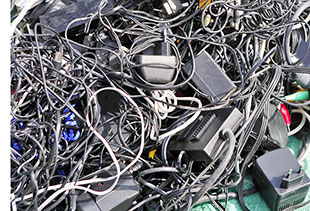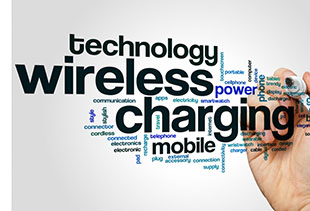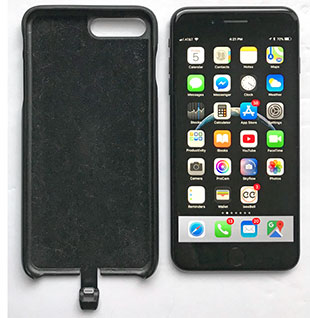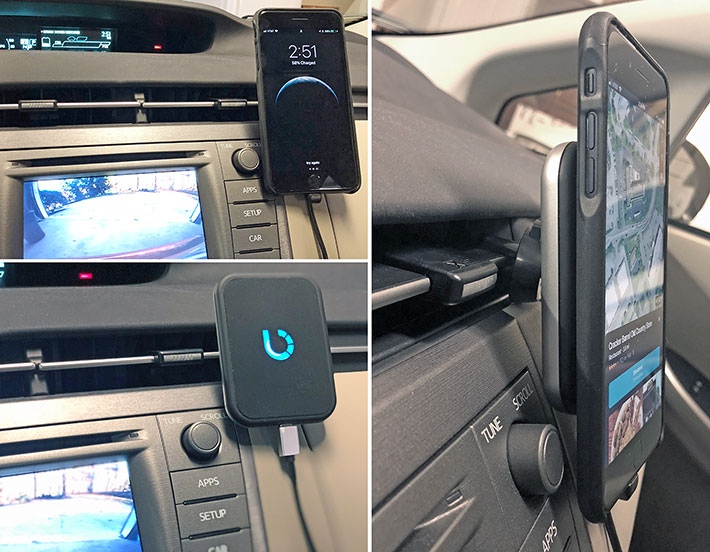|
Wireless Power
Bezalel's wireless power products — Wire-free charging is coming of age
(by Conrad. H. Blickenstorfer, January 2018)
Bezalel is a company that concentrates on wireless power. Their goal is "empowering all people to live free from the entanglement and chaos of all cords." Here at RuggedPCReview we've been using several of Bezalel's products for a few months, and so I'll report on my thoughts about wires and cord cutting first, and then of my experiences with Bezalel's wireless charging technology and products.
Getting rid of those pesky cords and wires
Wireless power, off course, has great appeal. Anything wireless has. Not needing a wire to get the job done seems a universally good thing. Back in the day, the English word for radio was wireless. The British listened to "the wireless." Telephones and telegraphs needed wires, the radio didn't.
 More recently, indvidual wires running from mainframes and mini computers to individual terminals were first replaced by LANs — still wire but much less of it — and now wired networks have mostly given way to WiFi, because WiFi doesn't need any wires at all. More recently, indvidual wires running from mainframes and mini computers to individual terminals were first replaced by LANs — still wire but much less of it — and now wired networks have mostly given way to WiFi, because WiFi doesn't need any wires at all.
Or look at phones. Cell phones took over because they aren't tethered to a wire. And even those who still use a "landline" generally prefer cordless phones.
On the TV and home entertainment front, people are "cutting the cord" by the millions. No more wire connections from the cable company or even the satellite dish. It's all wireless now.
The word "untethered" implies freedom. Freedom from tethers, cords, wires, anything that holds you back. The one type of wire we haven't been able to get rid of is the power cord. Almost everyone has a snakes' nest of them at home. If we only could get rid of all those cords, or even some of them. If we only didn't have to plug stuff in.
Wireless charging
Sadly, we're not quite in a position to cut all the cords. Most of the electronics that we've come to depend on in our daily lives must be plugged in. But we're now getting to a point where it's no longer everything. Wireless charging is quietly becoming more popular. With getting rid of cords and wires, it's just baby steps for now. But it's a beginning.
 It's baby steps because you still need a cord, the one that goes from the power outlet to the charger. But you no longer have to plug the wire directly into the device. All you have to do is place it on a special wireless charger. It's baby steps because you still need a cord, the one that goes from the power outlet to the charger. But you no longer have to plug the wire directly into the device. All you have to do is place it on a special wireless charger.
So for now that means you still need a wire, but at least you no longer have to fumble around trying to stick a tiny plug into a tiny receptacle.
How does wireless charging work? In essence the technology replaces wires to pass on electricity with an electromagnetic field to transfer power. The principle is to run current through a coil, thus converting it into magnetic waves. A nearby coil picks up those magnetic waves and converts them back into electricity. No wire is needed between the charger and the device to be charged.
Pros and cons
Replacing wired connections with wireless ones isn't always easy. A simple physical conduit, the wire, must be replaced with more complex wireless transmission. With radio and TV, wireless (antenna) reception can be iffy and subject to atmospheric conditions and interference. With WiFi, Bluetooth, RFID and such, distance sets limits and affects signal strength and thus transmission speed. With wireless charging, there are standards issues and conversion losses.
So what are the advantages and disadvantages of wireless charging?
On the plus side, simply having a charging surface somewhere definitely beats having wires cluttering up the place. And no one will miss having to plug and unplug devices with all those tiny connectors. No more tripping over charging cables. No more inadvertently ripping a power cord out of a device. No more frustration over a cord having the wrong connector.
- On the minus side, the wireless charging station still has a power cord, unlike USB charging that's available almost everywhere you need to take the wireless charger along, its an extra expense, and wireless charging is less efficient that a cord.
So is wireless charging perfect yet? It isn't, but it's a good start, and it will only get better. It's good enough for many leading smartphones to support wireless charging by now, and their number is growing.
Wireless charging standards
Is wireless charging a universal technology where one size ad standard fits all? It isn't, but the situation is quite acceptable with essentially just two standards, Qi (Wireless Power Consortium) and PMA (Power Matters Alliance).   Qi and PMA are similar but use different transmission frequencies and connection protocols. Qi is administered by the Wireless Power Consortium, PMA by the AirFuel Alliance which was formed in 2015 when the Power Matters Alliance (PMA) merged with the Alliance for Wireless Power (A4WP). Qi and PMA are similar but use different transmission frequencies and connection protocols. Qi is administered by the Wireless Power Consortium, PMA by the AirFuel Alliance which was formed in 2015 when the Power Matters Alliance (PMA) merged with the Alliance for Wireless Power (A4WP).
As is, both Qi and PMA use inductive charging technology that only works over the short distances and requires precise placement of the device to be charged on the charging surface. An alternate technology is resonance charging, which allows somewhat longer distances and allows charging of multiple devices at once.
There are many areas where multiple standards can co-exist because they may fill slightly different needs. Wireless charging isn't one of those areas. Multiple standards would be quite inconvenient. As is, the Qi standard has been around longer and thus is in considerably broader use, and Apple is supporting it (albeit with some proprietary angles). However, Starbucks decided to go with the rivaling PMA standard in its tens of thousands of locations. For now, a lof of companies ether take a wait-and-see position, or their devices support both standards.
What do you need to do wireless charging?
That depends on whether your smartphone is ready for wireless charging or not. If it is, all you need is a wireless charging surface. If it's not, you need both a wireless charging surface and an adapter for your phone.
Bezalel's wireless charging products
Bezalel Latitude iPhone 7/7Plus (Qi and PMA compatible)
 The Bezalel Latitude for iPhone is a wireless charging adapter available for use with the iPhone 6/6 Plus, 7/7 Plus, 8/8 Plus and iPhone X. For the 6 and 7 Series iPhones, the Latitude includes a charging coil because those iPhones are not inherently ready for wireless charging. 8 and X Series iPhones are ready, and those Latitude cases are simply protective cases with a magnet in it so they easily align on the wireless charging station. The Bezalel Latitude for iPhone is a wireless charging adapter available for use with the iPhone 6/6 Plus, 7/7 Plus, 8/8 Plus and iPhone X. For the 6 and 7 Series iPhones, the Latitude includes a charging coil because those iPhones are not inherently ready for wireless charging. 8 and X Series iPhones are ready, and those Latitude cases are simply protective cases with a magnet in it so they easily align on the wireless charging station.
We tested the Bezalel Latitude for iPhone 7 Plus (shown in picture to the right), which looks very much like the stock Apple iPhone silicon case that I bought with my iPhone 7 Plus.
Despite housing charging adapter electronics, the Latitude case is only negligibly thicker than the standard case, and it adds very little weight: the standard Apple case weighs 0.9 ounces, the Bezalel 1.6 ounces.
Since the iPhone 7 Plus doesn't have wireless charging built in, the Bezalel case charges the phone via a small lightning connector. That works well, but the little nub at the bottom of the phone means you can't lean your iPhone against something in portrait mode. I do that a lot, and so for me the charging nub often got in the way.
For the iPhone 7 Plus, the charging adapter case lists for $59.90.
So just to reiterate, the iPhone 6 and 7 Series need the Latitude charging adapter case because those phones do not have wireless charging electronics inside. The iPhone 8 and iPhone X Series were designed for wireless charging and do not need the Latitude charging adapter.

Now we're getting to the chargers themselves. Bezalel sent us its Futura X Wireless Charging Pad as well as its Bezalel Omnia Wireless Car Charger. The former (shown above next to the wireless Apple Magic Keyboard and Magic Mouse) is a sleek, elegant white 3.75-inch square, the latter a 2.75 x 3.75 black and silver rectangle with a clamp to attach to almost any vehicle's dashboard A/C vent (shown below).
Both have roughly three foot long USB cables, Micro-USB for the Futura and USB-C for the Omnia. We wish those cables were a bit longer and wonder why Bezalel uses two different kinds of plugs (perhaps to remind us how pesky all those miniature plug standards are?). Neither needs a bulky power adapter; the Futura plugs into any USB charging port, the Omnia has a car adapter. Both the Futura and the Omnia charge at 5 watts and get the job dones, although the iPhone 8 and X can charge at a maximum speed of 7.5 watts.

How did the Bezalel wireless charging products work? Flawlessly. They are also elegantly designed, down to the packaging and presentation. Does one absolutely need them? No, but then again, no one absolutely "needed" WiFi when it first became available. But people quickly found out that WiFi was so much more convenient than wires. That'll likely be the way it goes with wireless charging. -- Conrad H. Blickenstorfer, January 2018
Bezalel Latitude for iPhone 7 Wireless Charging Case
Bezalel Futura X Wireless Charging Pad
Bezalel Omnia Wireless Car Charger
|


